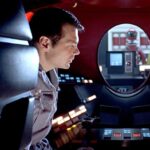2001: A Space Odyssey (1968)
This landmark movie transformed and elevated the entire genre of science fiction films by realistically portraying space exploration, spacecraft and space itself, and doing so via beautiful cinematography, creative special effects and an elegant, mostly classical score. It also dispensed with space movies’ lowbrow staples such as mutant space creatures, deadly space viruses, and silly-looking rocket ships. And it introduced the movie-going public to the then-obscure prospect of artificial intelligence.
Made during America’s real-life race to the moon in the 1960s, 2001 drew upon the futuristic vision of science fiction author Arthur C. Clarke and director Stanley Kubrick – and upon the meticulously authentic sets and space vehicle models created by production designer Harry Lange, a former head of future projects design at NASA. Longtime special photographic effects expert Wally Veevers also contributed mightily.
The film premiered in the United States at the Uptown Theater in Washington, D.C., on April 3, 1968 – the day before the assassination of the Reverend Martin Luther King, Jr., in Memphis. From the start, the critics differed widely about 2001. Some called it pretentious, or boring, or incomprehensible, but others regarded it as a milestone in film history and as the best science fiction film ever.
The film opens with an image of the sun, the moon and the Earth, to the majestic tones of the opening segment of Richard Strauss’s “Also sprach Zarathustra.” A title, “The Dawn of Man,” appears on the screen, and we see a moonscape-like desert, where apes and tapirs munch on plants. Later, the apes, grunting and screeching, gather around a water hole – but are driven off by another band of equally raucous and thirsty apes.
The next morning, our ape clan finds an alien object (pun intended) – a tall, black, smooth, rectangular column that emits a hum. The apes gradually overcome their fear and start touching the monolith. They quiet down and soon are caressing it.
https://www.youtube.com/watch?v=U2iiPpcwfCA
One of the apes then has an idea. He stares at a big bone, picks it up and starts smashing things. Soon the apes are munching not on plants but on tapir flesh. After that, armed with more big bones, they drive the other apes away from the water hole. The head ape (Daniel Richter in costume) triumphantly hurls his bone-weapon high into the air, and the scene cuts to a floating object of the same shape: a space vehicle, eons later, that orbits the Earth to the serene strains of Johann Strauss II’s “Blue Danube.”
Now in the film’s space age, we learn that the powers that be are closely guarding a secret: a tall, rectangular column has been found buried on the moon – evidence of extraterrestrial beings. Sent to the moon, a senior expert (William Sylvester) leads astronauts from a lunar base to the monolith. He touches it, as did the apes. The astronauts are driven back, seemingly overwhelmed by the monolith’s piercing sonic emissions.
Some 18 months later, a mission is en route to Jupiter. Crewmen Dave Bowman (Keir Dullea) and Frank Poole (Gary Lockwood) are aboard, as are three others who are in suspended animation. Responsible for “the brain and nervous system” of the ship is a HAL 9000 supercomputer (voiced by Douglas Rain) that has human-like intelligence and can converse with Dave and Frank. HAL, whose “face” is a red oculus, or lens, brags to a BBC interviewer back on Earth that no computer in his series has ever made an error.

After a bit, though, HAL starts asking questions about the mission. That troubles Dave and Frank, who plot to disconnect HAL if he goes haywire, so to speak. HAL reads their lips, however, and decides to kill the crew. Already having faked a malfunction, he cuts Frank loose when he is outside the craft dealing with it. Dave goes after Frank in a pod, but it is too late. HAL cuts off life support for the hibernating astronauts and refuses to let Dave return to the ship. Dave blasts his way in and then begins disconnecting HAL, which pleads with Dave but then slowly ceases to function.
HAL’s demise triggers a pre-recorded message that tells about the monolith and says the mission’s purpose is to find its source. After cruising by Jupiter, its moons and another monolith, Dave leaves his ship in a pod, and then somehow enters a hyperdrive-type state that sends him infinitely far away through a plane of psychedelic colors and landscapes. (LSD was big back then, and some fans took it during the movie.)
Finally, Dave, now elderly, arrives in a set of rooms with 18th-century French décor and sees – and becomes – even older versions of himself. A monolith appears. Soon we see a preborn baby floating in space, above Earth, as we hear “Also sprach Zarathustra” again. The title of Richard Strauss’s 1896 composition is taken from the novel by Friedrich Nietzsche in which he advances his philosophical concepts of the death of God, the ubermensch, and the transcending of morality.
The film, although sublimely beautiful in spots, is ultimately an atheist’s view of the universe. A metal monolith made by unseen beings is a poor substitute for the Creator and His providence. Nor is it exactly convincing as an evolutionary kick-starter. But the movie’s redeeming feature is the baby and the hope he represents. As the poet Carl Sandburg wrote in his only novel:
A baby is God’s opinion that life should go on…Never will a time come when the most marvelous recent invention is as marvelous as a newborn baby…Before man learned how to make an alphabet, how to make a wheel, how to make a fire, he knew how to make a baby – with the great help of woman, and his God and Maker. – Remembrance Rock, 1948
In real life, on Christmas Eve 1968, aboard the spacecraft Apollo 8 as they orbited the moon, astronauts Bill Anders, Jim Lovell and Frank Borman, with a billion people listening back home, gave the true view of the universe by reading from Genesis 1 (KJV):
“In the beginning God created the heaven and the earth… And God said, Let there be light: and there was light. And God saw the light, that it was good….And God called the firmament Heaven…”
— Dan Engler












